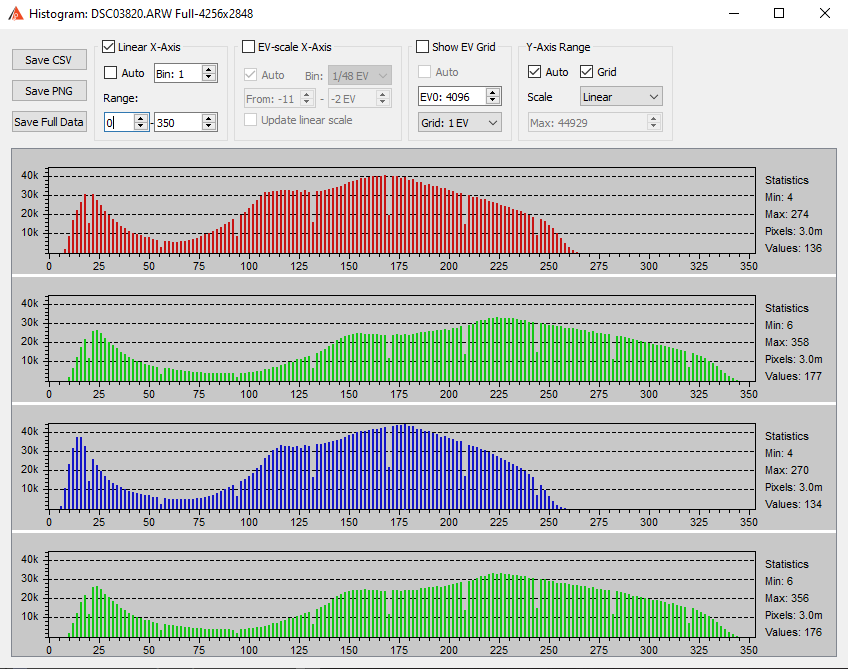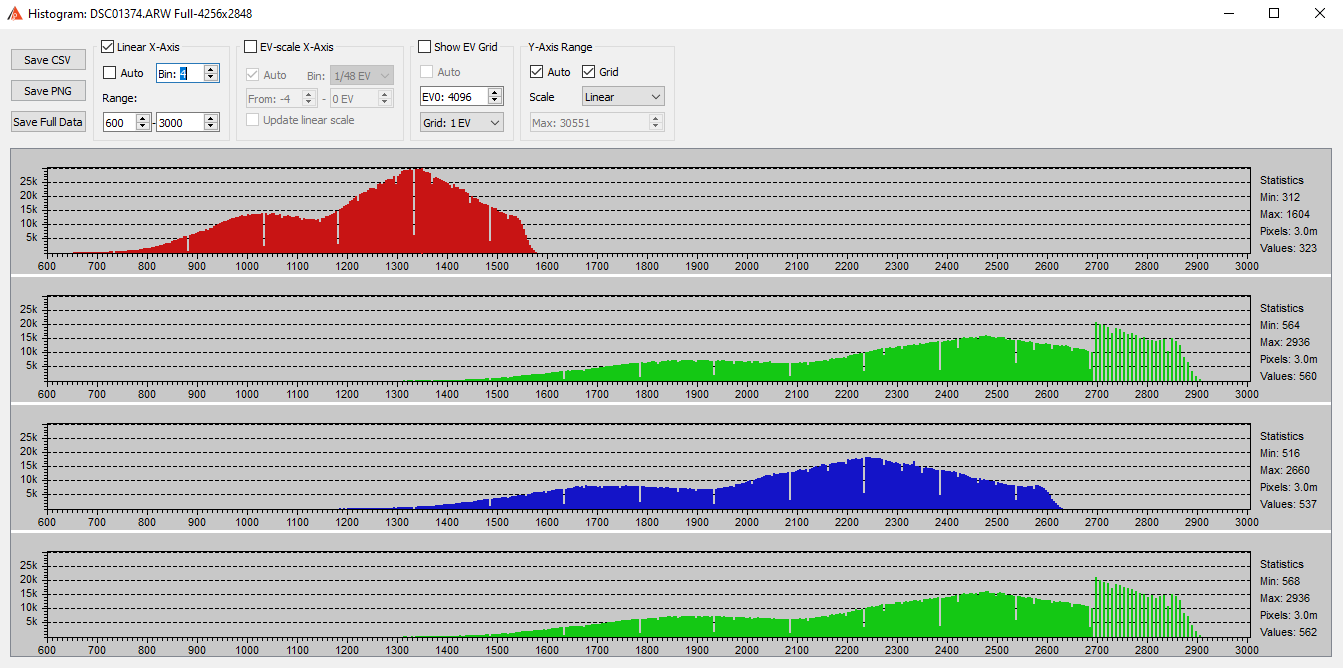Sony A7S Concentric Rings
Introductory Comments
The purpose of this web page is to document the Sony A7S coloured concentric rings caused by a scaling factor applied to the raw data during the in-camera processing.
Note that this is a different problem from the "polygonal" rings caused by a lens correction on Sony mirrorless cameras discussed here.
The problem of the split sensor causing horizontal bands in the left half of the sensor will also be discussed.
Example of Problem
For calibrated exposures, the rings can be embedded in either the light frames or the flat frames or both. For manual (i.e. non-bulb mode) exposures it is easiest to demonstrate the problem in low ISO flat frames.
In any case, here is a real world example of the problem. It's an ISO 100 1/250sec photo of sky and trees taken with a non-electronic legacy lens, unrecognised by the firmware. The image is deliberately 3 stops underexposed but pushed in processing:

The rings don't really become obvious until the saturation slider is used in Photoshop

To get a better understanding of the rings, it's best to avoid raw converters such as Adobe Camera Raw and RawTherapee. Simply debayer the (bias-subtracted) raw data, dividing one colour channel by another and then stretching to reveal the faint stuctures. Doing this on the above data using PixInsight gave the following result:

The rings are now very obvious. There is also a large chevron shaped artifact in the upper left hand side of the image which is caused by the fact the sensor is split into two halves, left and right. There will be more discussion of this later.
It's instructive to look at the histogram of the data:

The Sony A7S is supposed to be a 14-bit camera but the histogram contains only even values because of the lossy compression applied to the data. This is of no consequence but the important point to notice is that there are regular dips in the histogram at approximately every 38 units. This is indicative of a scaling multiplier that has been applied to the integer data. These dips are related to the rings found in the image. Every histogram dip corresponds to a ring in the image.
Admittedly this is only a minor problem for terrestrial photography but it becomes a problem for deep-sky astrophotography because the processing workflow designed to reveal faint structures and nebulosity in deep-sky images will also reveal faint artifacts embedded in the raw data by the scaling factor being applied.
Shooting in 12-bit Mode
When shooting Sony A7S light frames using 14-bit mode, the above problem with rings can be more or less eliminated by shooting at a higher ISO e.g. ISO 2000. ISO 2000 is a good choice anyway because this is where the HCG (high conversion gain) kicks in, resulting in much lower read noise. It is safe to shoot flats at lower ISOs because flats should always be well exposed.
However, 12-bit shooting introduces a new set of problems. It's not very well known that when using bulb-mode or silent shooting on the Sony A7S, the recorded bit depth drops to 12-bits.
Since I never used bulb mode after discovering that it triggers the Sony "star eater" raw data filtering, I first hit the problem of Sony A7S concentric rings when shooting flats using silent-shutter mode. Unknown to me at the time, the camera autoamtically reduces the bit depth to 12-bits in silent-shutter mode. The reduction to 12-bits would not cause a problem except that it also triggers a new set of histogram gaps!
Take a look at this histogram of a sky-flat taken in silent-shutter mode at ISO 100:

Two effects can be seen. Firstly there is a change in the histogram at around 2700 where the lossy compression switches from using every 2nd value to using every 4th value. This is of no consequence. The important thing to note is that the histogram "dips" now appear at intervals of around 152 instead of 38

Rings and Split Sensor
Here is the usual plot where I debayer the (bias-subtracted) raw data, dividing one colour channel by another and then stretching to reveal the faint stuctures.

The rings are quite obvious. As previously discussed, each ring corresponds to a "dip" in the histogram. Also obvious are the weird horizontal artifacts on the left half of the sensor which are caused by the left/right sensor split.
Mitigation of the Problems
On the Sony A7S sensor there are 2 problems that need to be overcome:
- Concentric rings caused by the histogram gaps in either 12-bit mode or 14-bit mode
- Weird horizontal artifacts in the left half of the sensor caused by the left/right sensor split
By experiment I found that light frames should be shot using ISO 2000 or higher and ensuring the peak of the back-of-camera histogram is at the halfway point. Flat frames should be shot with the back-of-camera histogram even further to the right.
I long ago decided to avoid bulb-mode shooting because of the Sony "star eater" raw data filtering, which limited my exposures to 30 seconds. With the fast optics of my Takahashi Epsilon 180ED telescope and my typical sky conditions I am forced to use ISO 10000 (yes, ten thousand) to ensure the back-of-camera histogram is at the halfway point.
Conclusion
For deep-sky astrophotography, the Sony A7S camera comes with the potential problems of concentric rings caused by histogram dips and weird horizontal artifacts on the left of the sensor. However, these problems can be avoided can using careful shooting strategies for lights and flats.
It's not certain which cameras are affected, though it's believed to be the A7S, A7 and A7R. I have no information about the 2nd, 3rd and 4th generation of the Sony mirrorless cameras.
Other Useful Links
DPReview Forum - Explanation of the sawtooth response
DPReview Forum - Contour banding discussion
DPReview Forum - Ripples in the photon transer curve
Last updated by Mark Shelley: 22 October 2023 (astro@markshelley.co.uk)